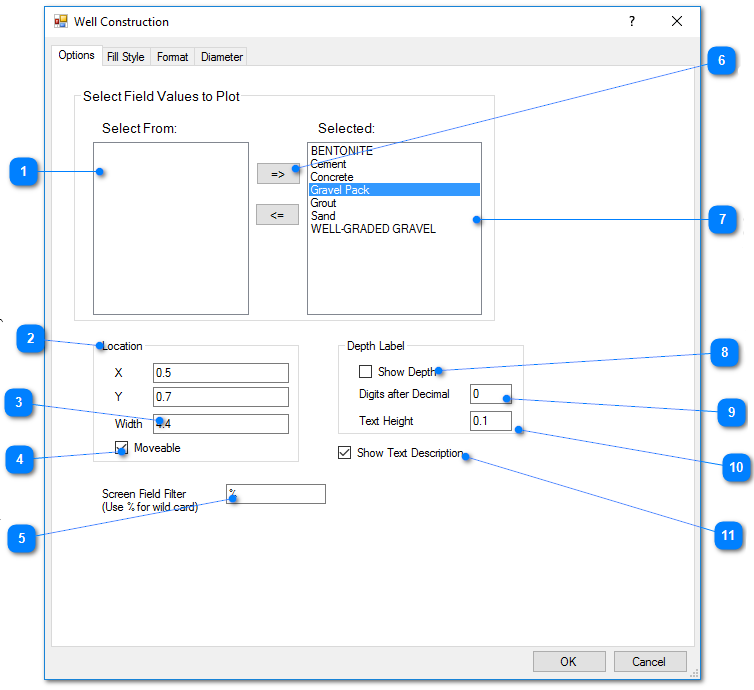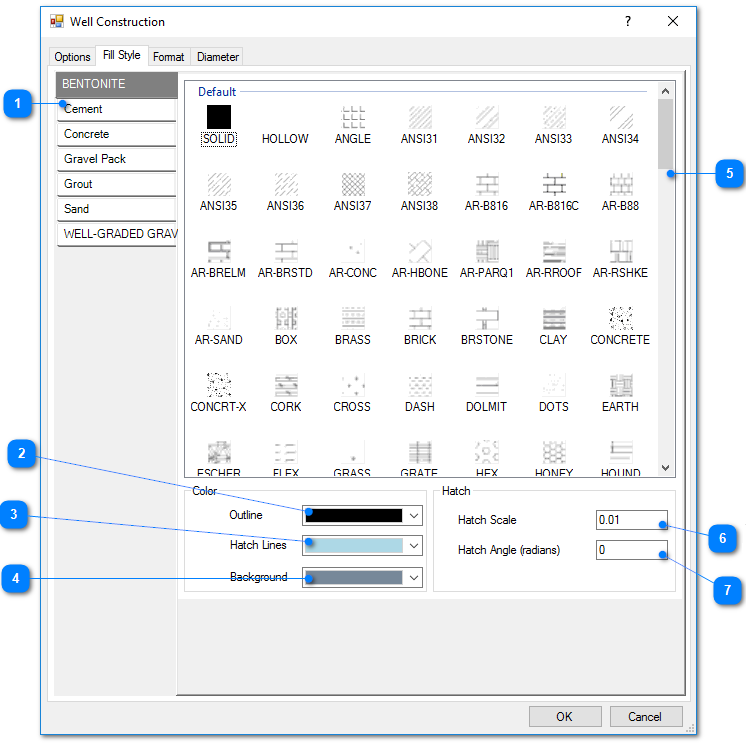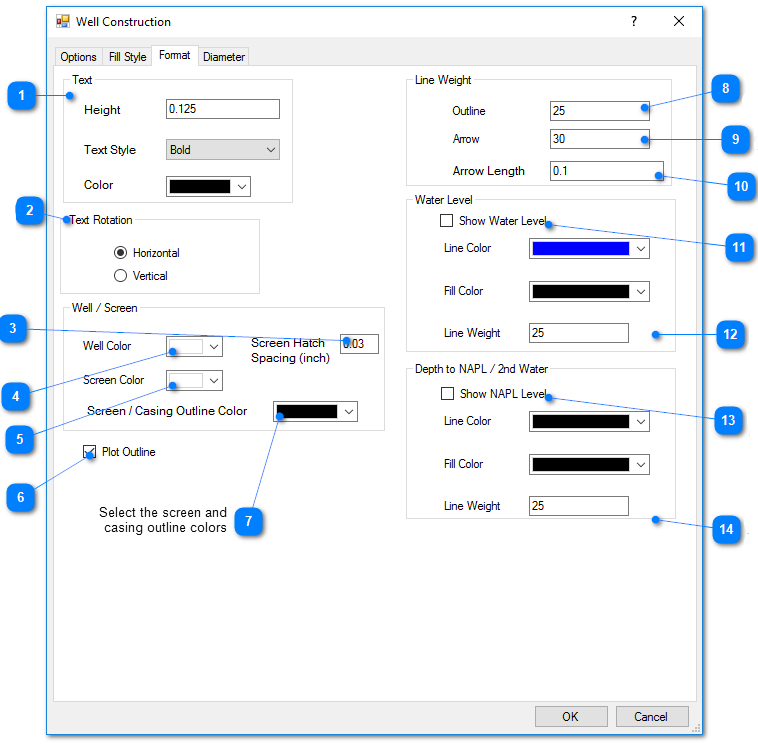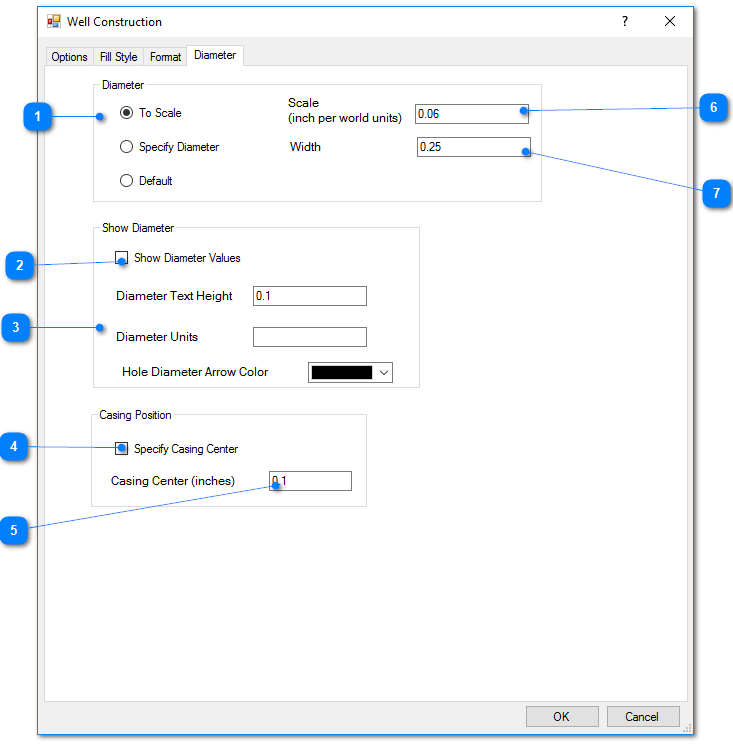The well construction diagram includes both the fill material used in construction of the well and the essential hardware, such as the casing, screen, surface casing, cap, etc. The hatch patterns used in representation of the fill material are selected from the Fill Style tab. Well construction diagrams may be drawn either to scale (so that the hole and infrastructure radii are of the same relative scale) or in a simpler representation that simply fills the allotted space.
Nested Wells
For non-EQuIS database users, nested wells may be displayed by placing a comma-delimited list of location IDs for co-located wells in the Colocated field of the Locations table.
For EQuIS-users, multiple screens or nested wells may be drawn by populating the DT_LOCATION.PARENT_LOC_CODE field for each of the nested wells. Multi-screen wells, where the screens are drawn aligned vertically, are indicated by not including a casing record in DT_WELL_SEGMENT for the locations representing the individual screens. Multiple generations may be used to draw a multi-screen well as the second of multiple nested wells.
Creating Well Construction Profile
Double-click on the well construction field to add it to the report. Once in the report, double-click the well construction object to open the Well Construction dialog box. Modify the Options tab, Fill Style tab, Format tab, and Diameter tab as desired. Click the OK button to save changes.
Check the Show Text Description box (#11 below) to have descriptions of individual well elements appear on the boring log. For EQuIS users, the text description will use:
•If Text Rotation (on the Format tab) is set to 'Vertical', DT_WELL_SEGMENT.MATERIAL_TYPE_CODE.
•If Text Rotation is set to 'Horizontal', the first non-null value of the following fields:
oDT_WELL_SEGMENT.REMARK,
oRT_WELL_SEGMENT_TYPE.MATERIAL_TYPE_DESC, or
oDT_WELL_SEGMENT.MATERIAL_TYPE_CODE.
Non-EQuIS users should place the text description values in the Notes field.
 1. Select Field Values to Plot - Select From: List of fill material IDs that may be drawn.
1. Select Field Values to Plot - Select From: List of fill material IDs that may be drawn.
2. Location: Enter page location of upper-left corner of well-construction diagram.
3. Location - Width: Enter width (in inches) of well construction diagram.
4. Location - Moveable: Place check to allow diagram to be moved using cursor/mouse.
5. Screen Field Filter (Use % for wild card): Enter Screen values to be used for representation of well screens, where "%" is wildcard character(s).
6. Select Field Values to Plot - Arrows: Click right- or left-directed button to add or remove from list of fill materials to be drawn.
7. Select Field Values to Plot - Selected: List of selected fill material IDs that will be drawn in resulting well construction diagram. Only fill materials from this list may be edited in the Fill Style tab.
8. Depth Label - Show Depth: Place check to print depth on well construction diagram.
9. Depth Label - Digits after Decimal: Enter # of digits after decimal for printed depth values.
10. Depth Label - Text Height: Enter height (in inches) of printed depth values.
11. Show Text Description: Place check to show descriptions of individual elements (source described above).
Hatch patterns will only be displayed when 'Specify Diameter' or 'Default' are chosen on the Diameter tab.

1. Fill Name: Select a fill material, for which the hatch pattern is to be selected.
2. Color - Outline: Select the color of the rectangular outline.
3. Color - Hatch Lines: Select the hatch-line color.
4. Color - Background: Select the background color.
5. Hatch Style: Select the hatch style for the selected fill material.
6. Hatch - Hatch Scale: Specify the hatch scale (increase if only the hatch line color is visible as solid object).
7. Hatch - Hatch Angle (radians): Set the hatch angle to rotate the hatch pattern.

1.Text: Specify the text format parameters.
2.Text Rotation: Select the appropriate button to place the descriptive element text either rotated so that it goes from the bottom towards the top of the page (Vertical) or from left to right (Horizontal).
3.Well/Screen - Screen Hatch Spacing: Enter the vertical distance (in inches) between the horizontal lines used to represent the screen interval.
4.Well/Screen - Well Color: Select the casing background color.
5.Well/Screen - Screen Color: Select the screen background color.
6.Plot Outline: Place check to draw outline around the well construction diagram.
7.Well/Screen - Screen/Casing Outline Color: Select the screen and casting outline colors.
8.Line Weight - Outline: Specify the outline weight (in 100ths of mm).
9.Line Weight - Arrow: Specify the arrow line weight (in 100ths of mm).
10.Line Weight - Arrow Length: Specify the arrow length (in inches).
11.Show Water Level: Place check to show water level within the well construction element.
12.Water Level - Line Weight: Specify the outline and fill color and line weight of the inverted triangle representing either the water table or NAPL elevation.
13.Depth to NAPL/2nd Water - Show NAPL Level: Place check to show the secondary water level or NAPL level.
14.Depth to NAPL/2nd Water - Line Weight: Specify the outline and fill color and line weight of the inverted triangle representing either the 2nd water table or NAPL elevation.
Note that hatch patterns will only be displayed when 'Specify Diameter' or 'Default' are chosen for the borehole diameter (see enumeration 1 below).

1.Diameter: Select the appropriate button to plot well-construction radii to scale, to specify the borehole diameter (in inches), or to allow the program to select a default value. Hatch patterns will only be displayed when 'Specify Diameter' or 'Default' are chosen.
2.Show Diameter - Show Diameter Values: Place check to show the element diameter values on the well construction diagram.
3.Show Diameter: Set the diameter text height and display units.
4.Casing Position - Specify Casing Center: Place check to indicate the casing center (otherwise calculated by program).
5.Casing Position - Casing Center (inches): Indicate the casing horizontal center in inches relative to the left edge of the well construction diagram.
6.Diameter - Scale (inch per world units): Set the diameter scale (only used if To Scale selected).
7.Diameter - Width: Set the borehole width (in inches; only used if Specify Diameter selected).